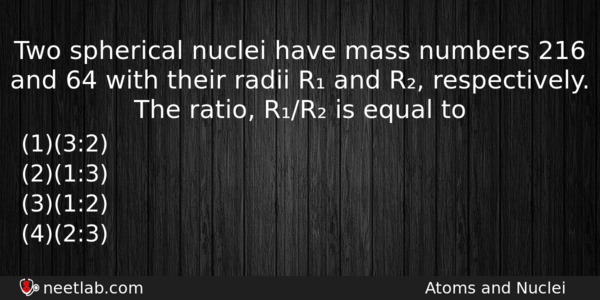| ⇦ | 
| ⇨ |
Two spherical nuclei have mass numbers 216 and 64 with their radii R₁ and R₂, respectively. The ratio, R₁/R₂ is equal to
Options
(a) (3:2)
(b) (1:3)
(c) (1:2)
(d) (2:3)
Correct Answer:
(3:2)
Explanation:
Radius of nuclei having mass number A is determined as
R = R₀ A¹/³ (where R₀ = constant)
where, R₀ = 1.2 x 10⁻¹⁵ m
This implies, R₁/R₂ = (A₁/A₂)¹/³ = (216/64)¹/³ = 6/4
R₁:R₂ = 3:2
Related Questions: - In a series resonant LCR circuit, the voltage across R is 100 volts and R =1kΩ
- A galvanometer of resistance 50Ω is connected to a battery of 3 V along with a resistance
- In a semiconductor
- For a diatomic gas charge in internal energy for unit charge in temperature for
- A particle moves in a straight line with a constant acceleration
Topics: Atoms and Nuclei
(136)
Subject: Physics
(2479)
Important MCQs Based on Medical Entrance Examinations To Improve Your NEET Score
- In a series resonant LCR circuit, the voltage across R is 100 volts and R =1kΩ
- A galvanometer of resistance 50Ω is connected to a battery of 3 V along with a resistance
- In a semiconductor
- For a diatomic gas charge in internal energy for unit charge in temperature for
- A particle moves in a straight line with a constant acceleration
Topics: Atoms and Nuclei (136)
Subject: Physics (2479)
Important MCQs Based on Medical Entrance Examinations To Improve Your NEET Score
18000+ students are using NEETLab to improve their score. What about you?
Solve Previous Year MCQs, Mock Tests, Topicwise Practice Tests, Identify Weak Topics, Formula Flash cards and much more is available in NEETLab Android App to improve your NEET score.
Share this page with your friends

R=R°A^1/3. (R°=constant
R1÷R2 =(A1÷A2)^1/3
=(216÷64)^1/3
=6÷4.
=> R1:R2 = 3:2